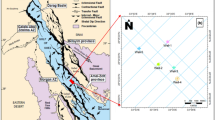Abstract
Sequence stratigraphic concepts for continental settings were assessed to analyze depositional systems of the formations penetrated by wells in the Otumara field. Identification and delineation of five sequences and their bounding surfaces was carried out using well logs. Reservoir sands A to D were mapped using conventional 3-D seismic interpretation techniques. Geostatistical simulation was carried out to provide equiprobable representations of the reservoirs, and the distribution of reservoir parameters and system tracts delineated from the stratigraphic framework. The modeled reservoir properties resulted in an improved description of reservoir distribution and connectivity. Reservoir sands A and B have the highest distribution of both highstand systems tract (HST) and lowstand systems tract (LST) deposits, while reservoir sands C and D have the lowest. Since reservoir sands C and D are from deeper depth, the results indicate that HST and LST decrease with depth while transgressive systems tract (TST) increases with depth. Correlating the 3-D geostatistical model with structures shows prospects with low and high hydrocarbon saturation. Crossplot of porosity and permeability for all reservoirs yielded good correlation. The crossplot of systems tract and hydrocarbon saturation with lithofacies as Z value shows a strong correlation of 0.89. The result also indicates that high hydrocarbon saturation is related to sandy facies of lowstand systems tract. Thus, the LST has the highest hydrocarbon potential. The models resulting from this study can be used to improve reservoir management and well placement, and to predict reservoir performance in Otumara field.

















Similar content being viewed by others
References
Alabert FG, Corre B (1991) Heterogeneity in a complex turbiditic reservoir: impact on field development. Society of Petroleum Engineers Annual Technical Conference and Exhibition, SPE paper 22902
Asquith G, Krygowski D (2004) Basic well log analysis, 2nd edition. AAPG Methods in Exploration Series 28
Avbovbo AA (1978) Tertiary lithostratigraphy of Niger Delta. AAPG Bull 62:295–300
Cross TA, Baker MR, Chapin MA, Clark MS, Gardner MH, Hanson, MS, Witter DN (1993) Applications of high-resolution sequence stratigraphy to reservoir analysis. COLLECTION COLLOQUES ET SEMINAIRES-INSTITUT FRANCAIS DU PETROLE 51:11–11
Dewan JT (1983) Essentials of modern openhole log interpretation. Pennwell Publishing, Oklahoma
Doust H, Omatsola E (1990) Divergent and passive basin of the Niger Delta. AAPG Mem 48:239–248
Ekweozor CM, Daukoru EM (1984) Petroleum source bed evaluation of Tertiary Niger Delta–reply. Am Assoc Pet Geol Bull 68:390–394
Esfahani NM, Asghari O (2013) Fault detection in 3D by sequential Gaussian simulation of Rock Quality Designation (RQD) Case study: Gazestan phosphate ore deposit, Central Iran. Arab J Geosci 6(10):3737–3747. doi:10.1007/s12517-012-0633-3
Haldorsen HH, Damsleth E (1990) Stochastic modeling. JPT 42(4):404–412. doi:10.2118/20321-PA. SPE-20321-PA
Klett TR, Ahlbrandt TS, Schmoker JW, Dolton JL (1997) Ranking of the world’s oil and gas provinces by known petroleum volume: US Geological Survey Open-file Report, pp 97–463
Kogbe CA (1976) Geology of Nigeria. Elizabethan Publishing Company
Kulke H (1995) Regional petroleum geology of the world. Part II: Africa, America, Australia and Antarctica. Berlin, GebrÃijder Borntraeger, pp 143–172
MacDonald AC, HÃÿye TH, Lowry P, Jacobsen T, Aasen JO, Grindheim AO (1992) Stochastic flow unit modelling of a North Sea coastal-deltaic reservoir. First Break 10(4):124–133
Mallet JL (2004) Space-time mathematical framework for sedimentary geology. Math Geol 36(1):1–32
Massonnat G, Alabert F, Guidicelli C (1993) Anguille Marine, a deep sea-fan reservoir offshore Gabon: from geology to stochastic modelling. SEG Technical Program Expanded Abstracts 1993:345–345. doi:10.1190/1.1822480
Mode AW, Anyiam OA, Aghara IK (2014) Identification and petrophysical evaluation of thinly bedded low-resistivity pay reservoir in the Niger Delta. Arab J Geosci. doi:10.1007/s12517-014-1348-4
Posamentier HW, Jervey MT, Vail PR (1988) Eustatic control on clastic deposition I conceptual framework, sea-level changes: an integrated approach. SEPM Spec Publ 42:109–124
Prévost M, Lepage F, Durlofsky L, Mallet JL (2005) Unstructured 3d gridding and upscaling for coarse modelling of geometrically complex reservoirs. Pet Geosci 11(4):339–345
Shannon PM, Naylor D (1989) Petroleum basin studies. Graham and Trotman Limited, London, pp 153–169
Shanor GG, Bahman S, Bagherpour H, Karakas M, Buck S, Carnegie A, Crossouard PA, Nasta V (1993) An integrated reservoir characterization study of a giant Middle East oil field: part 1–geological modelling. Proceedings of 8th Middle East Oil Show and Conference. SPE Paper 2(25657):491–504
Tuttle ML, Charpentier RR, Brownfield ME (1999) The Niger Delta petroleum system: Niger Delta province, Nigeria, Cameroon, and Equatorial Guinea, Africa. US Department of the Interior, US Geological Survey
Vail PR, Wornardt WW (1991) An integrated approach to exploration and development in the 90s: well log-seismic sequence stratigraphy analysis. Gulf Coast Association of Geological Societies Transactions 41:430–650
Van Wagoner JC, Mitchum RM, Posamentier HW, Vail PR (1987) Seismic stratigraphy interpretation using sequence stratigraphy. AAPG Stud Geol 1(27):11–14
Acknowledgments
The authors are grateful to the Department of Petroleum Resourses (DPR) and Shell Petroleum Development Company (SPDC), Lagos, Nigeria, for the provision of data, and Schlumberger, Nigeria, for donating workstations and Petrel software used for this study. We thank King Fahd University of Petroleum and Minerals (KFUPM) for supporting this project. We also thank Gabor Korvin for his useful discussion and contribution.
Author information
Authors and Affiliations
Corresponding author
Rights and permissions
About this article
Cite this article
Edigbue, P., Olowokere, M.T., Adetokunbo, P. et al. Integration of sequence stratigraphy and geostatistics in 3-D reservoir modeling: a case study of Otumara field, onshore Niger Delta. Arab J Geosci 8, 8615–8631 (2015). https://doi.org/10.1007/s12517-015-1821-8
Received:
Accepted:
Published:
Issue Date:
DOI: https://doi.org/10.1007/s12517-015-1821-8




